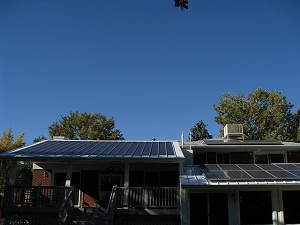Reviewing last week's solar energy news
 As summer swelters, deals on solar are getting hotter with more companies offering discounts on solar. Meanwhile some of the massive solar projects slated for construction moved one step closer to breaking ground. And legislation that could reopen a key financing mechanism for homeowners is being reintroduced to Congress. But the news isn’t all sunny for solar. Last week saw one company abandon its bid to install a large-scale array in Colorado, and the popularity of renewables is lower than it used to be.
As summer swelters, deals on solar are getting hotter with more companies offering discounts on solar. Meanwhile some of the massive solar projects slated for construction moved one step closer to breaking ground. And legislation that could reopen a key financing mechanism for homeowners is being reintroduced to Congress. But the news isn’t all sunny for solar. Last week saw one company abandon its bid to install a large-scale array in Colorado, and the popularity of renewables is lower than it used to be.
One Block Off the Grid introduced One Nation Off the Grid, a nationwide campaign that leverages group purchasing to bring down the cost of solar for homeowners. Under the program, homeowners in a geographic area can determine what deals are available locally and sign up through One Block Off the Grid’s Website. All profits from the One Nation Off the Grid campaign are being donated to nonprofit microlending organization Kiva City.
The One Nation Off the Grid is a nice opportunity for a discount on solar, but one California homeowner will get a free solar installation thanks to SunRun’s “Battle of the Bills” campaign. Under the Battle of the Bills, the California homeowner that submits the highest June 2011 electric bill to SunRun will get the company’s solar power service free for 20 years. Eleven other homeowners with high bills can receive up to $1,000 off a SunRun system.
he rebirth of Property-Assessed Clean Energy (PACE) financing programs may be at hand. PACE programs allowed homeowners access to lower cost loans and financing to install solar, renewables and energy efficiency retrofits though an easement on their home. But many communities stopped offering PACE programs when Freddie Mac and Fannie Mae warned that they could invalidate homeowners’ loans. The “PACE Protection Act of 2011,” is a bipartisan bill aimed to fix the issues and was introduced in the House by Representatives Mike Thompson (D-Calif.), Dan Lungren (R-Calif.) and Nan Hayworth (R-N.Y.).
Two of the world’s largest solar projects moved one step closer to breaking ground when Department of Interior (DOI) Secretary Ken Salazar approved their plans for transmission lines that cross land controlled by the Bureau of Land Management (BLM). The BLM also said it would revise the Draft Programmatic Environmental Impact Statement for Solar Energy Development (Draft Solar PEIS), which spans solar projects on federal lands in six states.
Even when they’re not hooked up, solar panels are still helping to insulate a building, according to a new University of California San Diego study. The study determined that roof-mounted photovoltaics help cool the building they’re on during the day and heat it during the night. Over their lifetime, the additional heating and cooling provided by a photovoltaic array can amount to a 5 percent discount on the solar panels’ price.
The U.S. Export-Import Bank has been working hard to promote the use of U.S.-made solar equipment internationally. Most recently it offered $25 million in loans to U.S. solar manufacturers exporting products to India. The recipients in this round of funding are First Solar and Abound Solar, both manufacturers of thin-film photovoltaics.
Across the pond, Great Britain’s feed-in tariff is ending July 31. As such, installers are scrambling to meet the deadline with operational systems before then. For instance, German company Conergy, just completed the largest solar array in the UK, a 5-megawatt installation that was completed in just six weeks.
Consumer knowledge about renewables is down from previous levels, according to the National Renewable Energy Laboratory (NREL). The number of people who care about renewable energy is high, at 80 percent, but it has fallen slightly from previous years, according to the Natural Marketing Institute, which conducted a survey about sustainability.
Tessera Solar dropped its bid last week to install what was originally to be a 200-megawatt concentrating solar plant. The company said that ongoing studies and the lack of a power-purchase agreement with a local utility made the project less feasible.
Photo: Chris Meehan / Clean Energy Authority.



